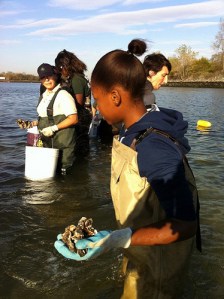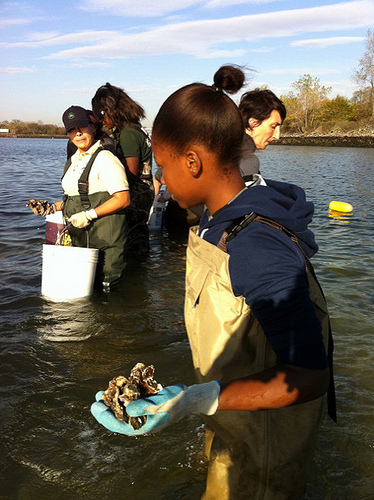
Oysters used to be so plentiful in NYC, you'd see piles of the shells on the sidewalks. (Photo by New York State Archives.)
While today’s New Yorkers gladly gulp down oysters in some of the city’s fanciest restaurants, many are unaware that the oyster trade used to be one of the most important industries in the area.
“Oysters were on every street corner the way that hot dog stands are today,” says Emily Driscoll, director of the new documentary, Shellshocked. “[They] were so ingrained in culture and society, then completely vanished in a couple of decades.”
The film, whose full title is Shellshocked: Saving Oysters to Save Ourselves, explores the crucial role these shellfish played in New York’s environmental and cultural past, as well as the movement to make a place for them in the city’s future.
Once upon a time, New York Harbor was lined with 300 square miles of oyster reefs (around 260,000 acres). Then, as now, the bivalves were threatened by pollution. In the early 1900s, typhoid and cholera outbreaks were traced to oysters from Staten Island and many oyster farms were shut down. Since then, their presence has been almost erased from the city’s collective memory.
The oysters’ disappearance is a problem for more than just epicureans. Much as coral does in the tropical seas, oyster reefs can provide the foundation for an entire marine ecosystem in temperate waters. Additionally, oysters play a key role in removing excess nitrogen from the water system, and excess nitrogen in the Hudson River Estuary System has led to an explosion of algae, crowding out fish and other wildlife.
New York’s oyster reefs once made up the “dominant ecosystem of the area,” says the aptly named Murray Fisher, program director of the New York Harbor School. Founded in 2003 as a part of the New York City public school system, the Harbor School plays a key role in running an oyster restoration project that Driscoll chose to feature in Shellshocked.

Photo by Oyster Restoration Research Project.
The school trains around 420 high school students in six environmental and maritime tracks including aquaculture and marine biology research. Currently, students are growing oysters from a shipment of 1.5 million larvae (or oyster seeds). All of the larvae are Eastern oysters, the same species that inhabited the harbor and the rest of the Atlantic coastline 100 years ago.
“There are 1.1 million kids in the New York City public school system and the New York Harbor is still one of the richest water habitats in the world,” says Fisher. “But it’s become very degraded and disconnected from those 1.1 million kids.” If New York wants to manage its marine ecosystem well over the next several hundred years, he adds, the next generation of New Yorkers will need to feel a connection to the harbor — and have the skills, knowledge, and training to manage it.
A native New Yorker from age 7, Driscoll was similarly seeking to bridge the divide that exists between the city’s inhabitants and their natural surroundings. “A lot of New Yorkers forget that this is an island and we’re surrounded by this incredible body of water,” she says.
Another way to cultivate this connection to the harbor is through art, such as the work of Mara Haseltine, an environmental artist and professor at The New School. Haseltine began designing porcelain oyster shells when she learned about restrictions that prevented empty oyster shells from restaurants being returned to the water. The porcelain shells can be placed in the water, providing additional oyster habitats. Haseltine also creates larger-scale structures to which the oysters can attach and describes her work as “creating skeletons for future aquatic life.”
Driscoll believes the efforts to restore these oyster reefs can set an example for other communities with ecosystems at risk. “People can work within their own expertise to put oysters back in the water. The Harbor School sets an incredible example of protecting and restoring an ecosystem in their own backyard. Mara worked with what she had.”

A U.S. Army Corps of Engineers crew drops rock material into the water in order to create an artificial oyster reef off of N.Y.C.'s Governors Island. (Photo by USACE Public Affairs.)
The bitter irony? Even if Haseltine, the students at the Harbor School, and others succeed at bringing back the New York oyster population, they’ll still be too toxic to eat. Unless you like high levels of dioxin, PCBs, mercury, and bacteria from sewage runoff.
“If it rains more than one-16th of an inch in N.Y.C., it overwhelms the sewage treatment plants, and they shut them down and all rainwater and raw sewage is combined and overflows into the harbor. That happens 60 times a year,” explains Fisher.
Nonetheless, oysters can play a key role in mitigating New York Harbor pollution and enabling other species to survive. The efforts to regenerate the population are especially needed as ocean acidification and a rise in diseases linked to climate change pose new threats for the mollusks.
“There’s so much more that needs to be done to restore waterways, in addition to bringing the oysters back,” adds Driscoll. “Oysters are incredible creatures but they can only do so much.”
Watch the trailer for Shellshocked:


